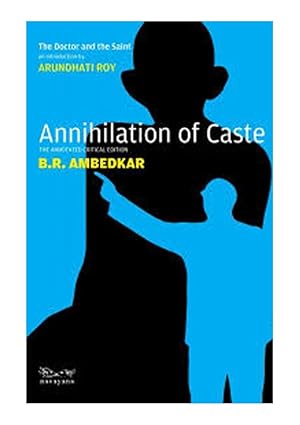
Original Title
Annihilation of Caste
Subject & College
Publish Date
1936-05-15
Published Year
1936
Publisher, Place
Total Pages
415
ISBN 13
9788189059675
Format
Paperback
Country
India
Language
English
Readers Feedback
An Undelivered Speech
The Jat-Pat-Todak Mandal, an organization working for social reform, invited Dr. B.R. Ambedkar to deliver the keynote address at its annual conference in Lahore. Dr....Read More
Syed Rizwan Ali Syed Javed Ali
An Undelivered Speech
The Jat-Pat-Todak Mandal, an organization working for social reform, invited Dr. B.R. Ambedkar to deliver the keynote address at its annual conference in Lahore. Dr. Ambedkar, a prominent social reformer and advocate for caste abolition, accepted the invitation. However, after reading the draft of his speech, the Mandal asked him to soften his criticism of Hinduism. Dr. Ambedkar refused to dilute his message.
As a result, the event was canceled, and the Mandal withdrew its invitation. So, Dr. Ambedkar decided to publish the speech himself. He distributed copies to the public, suggesting that the Mandal might have faced backlash for inviting him. He pointed out that, according to Hindu religious doctrine, only Brahmins have the authority to preach. Quoting the Manusmriti (10.3), which states, “Among varnas, the Brahmin is the teacher,” he highlighted how the text enforces caste-based authority. It forbids Hindus from accepting anyone outside specific castes as their guru, regardless of their knowledge or wisdom.
The speech was a fearless critique of Hinduism and its caste system. Dr. Ambedkar argued that religion should be used to promote equality and build an inclusive society. He repeatedly urged Hindus to reject caste-based discrimination, emphasizing that true social justice could only be achieved by completely abolishing the caste system.
Ambedkar’s arguments are deeply rational and supported by evidence. He meticulously analyzed Hindu scriptures, such as the Manusmriti, to show how religious texts institutionalized caste inequality. Despite being written nearly 90 years ago, the book remains relevant today. Even after 75 years of independence, caste-based discrimination persists in India, with frequent incidents reminding us of the deep-rooted problem. Arundhati Roy, in the introduction of the book, discusses the ideological differences between Gandhi and Ambedkar. She explains that Gandhi did not use his influence to challenge the caste system. Instead, he supported it, claiming it was necessary for maintaining social order. Roy also highlights the current situation of lower-caste people in India, pointing out that most important government positions are held by individuals from upper castes. Dr. Ambedkar’s vision of social justice was grounded in modern democratic values: liberty, equality, and fraternity. Unlike Mahatma Gandhi, who supported the Varnashrama system (while opposing untouchability), Ambedkar called for the complete eradication of caste system. He criticized the religious foundation of caste, arguing that texts like the Manusmriti glorified discrimination and denied basic human rights to marginalized communities.
To explain how deeply rooted the caste system in India is, Ambedkar gave historical examples that showed how religion influenced Indian society. He highlighted how theocratic priests held more power than magistrates and how religion was often used to manipulate social issues. According to Ambedkar, upper castes benefitted from the hierarchical structure and were generally unwilling to dismantle it. They resisted reforms that threatened their privileges, perpetuating the inequality faced by lower castes.
Ambedkar emphasized the need for social reform at two levels: within families and society at large. At the family level, he spoke about issues like widow oppression and the importance of women’s education. At the societal level, he called for abolishing untouchability and ensuring equality, stressing that every individual deserves dignity and justice.
Dr. Ambedkar envisioned a society where every individual, regardless of their caste, could live freely and make their own life choices. He believed that all citizens have equal rights to the resources of their country. He argued that assigning work based on caste not only limits people’s natural potential but also suppresses their aspirations. According to him, humans should not be divided by caste but rather by their actions and qualities, such as good or bad, wise or foolish, knowledgeable or ignorant. Annihilation of Caste is more than just a book. It is a revolutionary manifesto that challenges centuries of oppression. Dr. Ambedkar’s unapologetic critique of caste-based discrimination and his vision for an egalitarian society remain crucial for understanding India’s socio-political reality. This work is a must-read for anyone committed to equality, justice, and human dignity.
